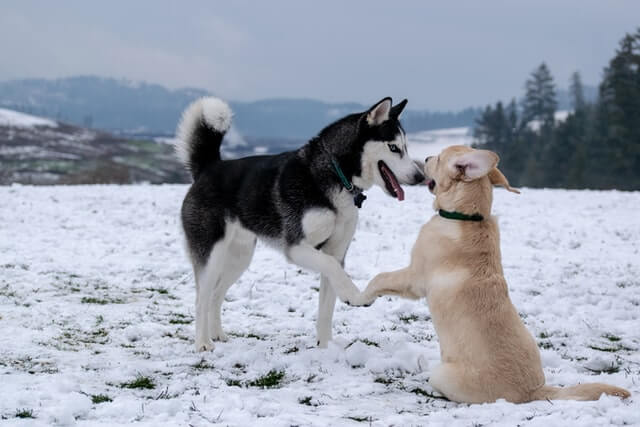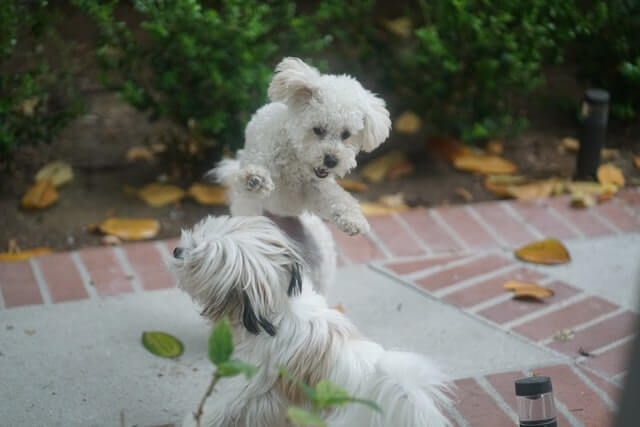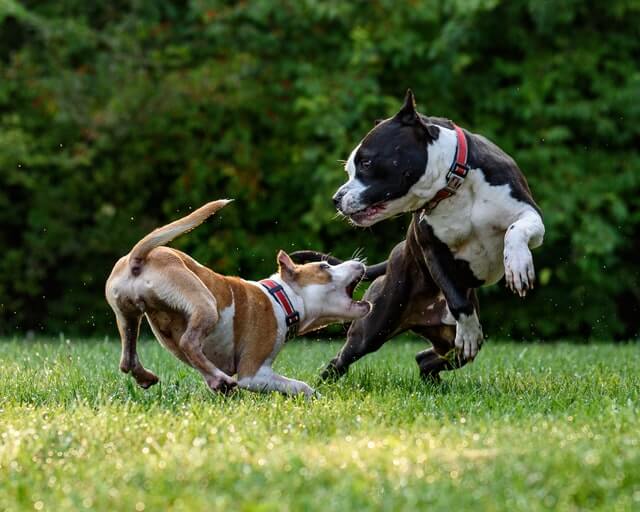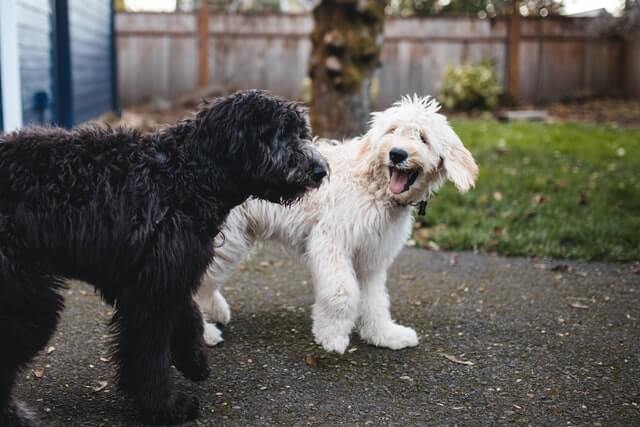The decision to have a second dog is an important and responsible step. When you bring another pet into the house, you may face problems such as jealousy, disobedience, and aggression. To avoid this kind of trouble, you need to know how to stop dogs from fighting in the same household, befriend another pet, and make their life together as pleasant as possible for each other and also for you. All dogs, without exception, need socialization, even puppies.
An important detail – if you have a problem with the hierarchical relationship with the dog, you need to solve it before bringing a new furry friend into the house.
How to Prevent Fights Between Your Dogs
- The first meeting should be “at eye level”. Meeting in the home gives the first dog a territorial advantage, so it is better to meet pets on the street. After the walk, the pet will be calmer about the intrusion of a new resident into its area, but once the pets enter the house, they should be confined to different rooms and fed;
- Dogs should be calm and slightly tired during the acquaintance. It is better not to let them off the leash. Do not pull or tug, but control the situation so you can intervene if necessary;
- Do not encourage rivalry. Dogs can be territorial about food or toys. Some breeds are more inclined to protect their property, while others like to share it. To do this, you need to know your pet’s character traits;
- Give equal attention to dogs, avoid jealousy in one of the pets, but strictly stop trying to dominate;
- You cannot violate the “personal space” of the first pet. rearrange his bed and bowl, put next to or in its place a bed or bowl of a newcomer. This may provoke old-timers to defend their territory;
- The best option is to put pets in different rooms or at least feed them in separate rooms;
- Teach your pet to eat only from his bowls;
- Teach your dog to play safely. When you first bring a dog home, it is your responsibility to teach it not to attack others. Use positive incentives to encourage good behavior. If it bites, growls, or otherwise misbehaves, separate it from the other dog it is playing with and leave one until it calms down;
- Never allow dogs to stay together when toys are around. Toys are triggers for fights. NO TOYS should be placed nearby. They need to know that all toys are yours to play with from time to time but are always taken back after playtime;
- Teach your furry friend to come to your call. If he is obedient when you call her, you can get her out of most stressful situations before they grow into something bigger. Start teaching her to come to the call and stay close when she is young. Practice this often, especially around other dogs;
- Encourage good behavior in your pets. It will teach them what is right and what is wrong;
- In extreme cases, if you are unsure of the situation, both dogs should be in the mouth;
- The easiest option is to go to a dog club. There, the animals play and get used to each other under the supervision of experienced dog breeders and trainers.
The trick is that you only need two soft, damp clothes to befriend another dog. Wipe one pet or the other with a piece of cloth and spread them out in different rooms, leaving the cloth with the scent of another dog. This will help them get used to each other faster.

How to Introduce an Adult Dog to a Puppy
The best option for a second pet is to get a puppy. It is in the nature of dogs to have a friendly and forgiving adult attitude towards children. If your older pet has been socialized, there should be no problems. But still don’t let the process of dating and habituation drift.
To introduce your pet living in the house to a newly acquired puppy, you need to show him that this new creature also has the right to be a neighbor, and the owner is interested in the fact that the baby is not offended.
- To do this, together with the newcomer, bring new bowls and a blanket – it shows the dog that the baby does not claim his things;
- Release the puppy and show the adult dog how to sniff properly. Stop all unwanted actions on their part with a strict ban;
- Puppies carry their mother’s scent, so it’s best to wash them with a neutral shampoo before the appointment;
- Watch your baby’s behavior – it should not flirt or become too obsessive, so as not to irritate the older pet. If the puppy is too active, it should be temporarily moved to another room to give it time to calm down;
- Most adult dogs are loyal to their puppies and quickly lose interest in the new resident. If an adult behaves in a threatening manner, be sure to report it and drive it to the site;
- If you feed your baby, you can give some of its food to another pet, which will greatly appreciate such an offer, as it will see the positive side of the puppy’s stay in its territory;
- It is important to feed them from their bowls so that the baby cannot taste the dog food;
- The dog may also lie on the puppy mat; this is allowed. The more pleasant moments she has with her new neighbor, the more likely they will become friends;
- Walking together is a very important moment. If your first dog is well-behaved and follows and obeys commands unconditionally, this is a big plus. The child begins to actively copy the behavior of the older pet. The process of raising and socializing a puppy is greatly facilitated and accelerated.
If you decide to get a puppy of another breed as a second pet, be sure to take into account the differences in size, temperament, and character of the dogs. It will be difficult if too many pets get along in one home.

How to Keep Dogs from Fighting
The best way to stop a fight is to prevent it from starting. Watch your pet closely, and if you think he (or another dog) might get angry, just walk away from the situation until nothing happens.
The first step is to UNDERSTAND THE DIFFERENCE BETWEEN FIGHTING AND PLAYING. If you know what behavior your dog normally exhibits in the company of other dogs, it will be easier to understand the beginning of the fight that needs to be stopped.
Learn your dogs’ behavior in play – watch how it interacts with other pets:
- Barking, jumping, or biting other dogs during play;
- How cruel it can be in a normal game;
- Observe their bodies – if they look free and relaxed and are wagging their tails, they are probably just playing. However, if the bodies are tense and the tails are squeezed, there is most likely the possibility of a fight;
- Observe if they are equally interested in the game. Sometimes one dog will play, and the other will not go. In this case, you need to stop the game, even if your dog has not planned anything bad.
How to Stop Dogs From Fighting
- Determine what provokes a fight and eliminate that factor. For example, it may be a fight over food. If so, make sure there is enough food for both;
- Distract them from each other;
- Spray them with water. One of the easiest ways to break up a fight is to pour a bucket of water or pour it from a dog hose. This will immediately stop their attack instinct, and each of the dogs will forget about their aggression towards each other. In most cases, the dogs will simply scatter;
- Scare them with a loud noise. Bang two metal objects above their heads or use a sonic horn to scare them. If you don’t have something like that on hand, try clapping loudly or yelling. Sound has the same effect as water. They will forget why they were fighting and disperse;
- Use a barrier to separate them. It can be a large piece of cardboard, plywood, or a lid from a trash can;
- Throw a blanket over them. Some dogs will stop fighting if they can’t see each other. If you don’t have a large blanket, try throwing a tarp or other opaque material over the dogs to calm them down;
- With the help of an assistant, pull the dogs in different directions. Each person should approach the dog from behind, grab the dog by the tail or hind legs, and pull them away from the opponent. After that, you need to distribute quarreling pets in different directions as quickly as possible;
- Keep pets away from each other. They might start fighting if they see each other again. Lock the dog behind the door or put it in the car as soon as possible;
- Muzzle the offender and do not remove it until feeding time. A few days of such punishment will give the dog a clear understanding that this is impossible;
- Be sure to encourage both pets to behave well.
If you can’t separate them, doing things together is not always easy either. But there is a way to get a dog to open its jaws. To do this, you need to pinch (squeeze, squeeze) it very sensitively in the groin (behind the genitals). It changes its attention and can open its jaws. Making a loop from a leash and throwing it on the dog’s hind paw is also recommended. This will make it safer to bring the dog to safety. However, such a loop should not be thrown around the animals’ necks!

What Not to Do
1. Hit the pet: During a fight, it is unlikely to feel pain – on the contrary, blows can irritate him;
2. Do not stretch the jaws of pets with your hands – you may hurt yourself: No need to swing your arms, legs, or a dog. This not only encourages the attacker but also risks becoming a victim;
3. DO NOT grab it by the collar: This may be the first impulse, but in this fight, you risk being bitten if you reach for the collar. The dog will instinctively get out and bite, even if he has never shown aggression. When their bodies are tense and it’s clear they are fighting, not playing, don’t risk squeezing their hands. There are better ways to stop this.
Conclusion
In conclusion, harmonious coexistence among dogs in the same household is achievable with the right knowledge and strategies. As we’ve explored in this guide on how to keep dogs from fighting, understanding the underlying causes of fights and addressing them effectively is crucial. By focusing on prevention, communication, and fostering a positive environment, you can significantly reduce the likelihood of conflicts between your furry companions.
Remember that each pet is a unique individual with its own personality, triggers, and preferences. Therefore, it’s essential to tailor your approach to the specific dynamics at play in your home. Implementing a gradual introduction process for new furry friend, emphasizing positive reinforcement, and practicing consistent training can go a long way in preventing fights and promoting a sense of unity among your four-legged family members.
FAQ
Can dogs live together after fighting?
Yes, they can often live together after fighting, but it depends on various factors. It’s crucial to assess the underlying causes of the fights and address them to prevent future conflicts. Gradual reintroduction, positive reinforcement training, and creating a structured environment can help them rebuild trust and coexist peacefully. Seeking guidance from a professional trainer or behaviorist can also provide valuable insights on how to manage and improve the relationship between pets that have fought.
Should I let my dogs fight it out?
No, allowing dogs to fight it out is not recommended. Fights can escalate quickly and result in serious injuries, both physical and emotional. Instead of allowing them to fight, focus on preventing fights from occurring in the first place. Intervene if you sense tension building, separate them, and work on training and management techniques to address their behaviors.
How long should I keep my dogs apart after a fight?
The duration of keeping dogs apart after a fight can vary based on the severity of the fight and their temperaments. It’s generally a good idea to keep them separated until you can ensure their safety and until their tension has subsided. This could range from a few hours to a few days. Gradually reintroduce them under controlled circumstances once they seem more relaxed, and closely monitor their interactions.
How do you know if a dog fight is serious?
A serious fight may involve aggressive behaviors beyond simple play or a display of dominance. Signs of a serious fight include prolonged and intense growling, snapping, biting, lunging, and inflicting injuries. Those involved in a serious fight might have dilated pupils, erect ears, raised hackles, and intense body language. If the fight results in injuries or seems unprovoked, it’s crucial to seek professional help from a veterinarian or a certified behaviorist to address the underlying causes and prevent future conflicts.
